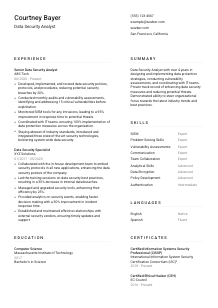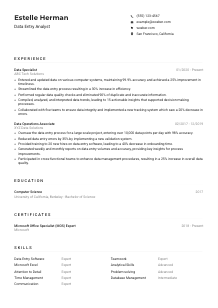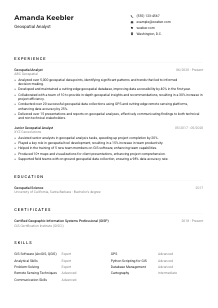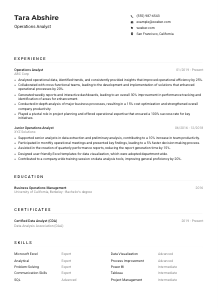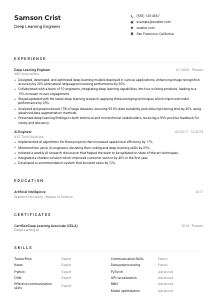Data Security Analyst Resume Example
Guarding digital fortresses, but your resume feels hackable? Encrypt your credentials with this Data Security Analyst resume example, encrypted with Wozber free resume builder. See how you can seamlessly armor your data defense skills to protect as per job specifications, making sure cyber threats always hit a virtual brick wall!

How to write a Data Security Analyst Resume?
Stepping into the realm of Data Security Analyst requires more than just expertise; it requires showcasing your skills in a document that speaks volumes—your resume. The challenge? Making sure it resonates with recruiters while passing the ever-watchful eyes of Applicant Tracking Systems (ATS).
Fear not, as this guide, powered by Wozber's free resume builder, is tailored to help you create an ATS-compliant resume that aligns perfectly with your dream job's requirements. Ready to lock down your future role with an encrypted strategy?
Personal Details
The key to opening doors in the data security field begins with how you present your personal details. Let's ensure this section is not just filled, but strategized to position you as the ideal candidate for the Data Security Analyst job.
1. Your Name as Your Brand
Think of your name as the secure header in a packet of data. It should be clear and prominent, just like how you'd ensure a data packet isn't lost in transmission. Opt for a legible font that makes sure your name is the first thing that captures attention.
2. Align Your Title
Directly below your name, specify your targeted job title, 'Data Security Analyst,' as it aligns with the vacancy. This immediate categorization helps the ATS and the hiring manager recognize your career focus, akin to specifying the protocol type for data packet routing.
3. Make Contact Details Bulletproof
Your contact information is the handshake protocol in this communication. Include a professional email and a phone number you regularly monitor. Verify these details as meticulously as you would a firewall rule to ensure there are no typos.
4. Geo-Tag Yourself
Mentioning 'San Francisco, California' directly matches one of the job's prerequisites. This acts as geotagging in metadata, showcasing your availability within the desired locale without necessitating relocation protocols.
5. A Professional Online Presence
If you have a LinkedIn profile or a personal website that showcases your professional achievements or portfolios, include it. This can be thought of as providing a URL for deeper investigation into your professional background.
Takeaway
Your personal details section sets the digital handshake between you and potential employers. It's more than data input—it's the first signal of matching frequencies. Crafted correctly, it forms a strong signal-to-noise ratio in your favor, ensuring you stand out in the digital crowd.





Experience
The experience section is where you encrypt your achievements and responsibilities with the job requirements, turning them into a compelling narrative. Let's delve into rendering these details in a way that not only passes ATS scrutiny but also engages the hiring manager.
- Developed, implemented, and revised data security policies, protocols, and procedures, reducing potential security breaches by 20%.
- Conducted monthly audits and vulnerability assessments, identifying and addressing 15 critical vulnerabilities before exploitation.
- Monitored SIEM tools for any intrusions, leading to a 95% improvement in response time to potential threats.
- Coordinated with IT teams, ensuring 100% implementation of data protection measures across the organization.
- Staying abreast of industry standards, introduced and integrated three state‑of‑the‑art security technologies, bolstering system‑wide data security.
- Collaborated with the in‑house development team to embed security protocols in all new applications, enhancing the data security posture of the company.
- Led the training sessions on data security best practices, resulting in a 30% decrease in internal data breaches.
- Managed and upgraded security tools, enhancing their efficiency by 25%.
- Provided analytics on security events, enabling faster decision making with a 50% improvement in incident response time.
- Established and maintained effective relationships with external security vendors, ensuring timely updates and support.
1. Analyze Job Requirements
Initiate by dissecting the provided job description, tagging each requirement with your corresponding experience. This process is akin to mapping out the architecture of a secure network—each element must align with a specified role.
2. Employ a Strategic Structure
Organize your experiences in reverse chronological order, ensuring your most recent and relevant achievements are most visible. Think of this as prioritizing traffic in network security, where the most critical data packets are given precedence.
3. Encode Achievements
For each role, describe your accomplishments in the language of the job description. Tailoring your achievements, such as "Developed, implemented, and revised data security policies," directly correlates to the job's demands, ensuring a seamless match.
4. Quantify Your Impact
Numbers carry significant weight. Quantifying your achievements, like "reducing potential security breaches by 20%," offers tangible evidence of your impact, much like statistical analyses in data security efforts.
5. Maintain Relevance
Stay focused on experiences directly pertinent to data security. Extraneous information may dilute the strength of your application, similar to how irrelevant data can clutter network traffic.
Takeaway
Immaculately presented, your experience section is a testament to your qualifications, echoing the necessity for precision and relevance in the field of data security. Let each responsibility and achievement you list serve as a credence to your ability to fortify and protect digital assets.
Education
In the data security realm, your educational background forms the foundation of your expertise. We'll ensure this section is more than a formality—it's a testament to your preparedness for the role.
1. Target the Essential
Highlight your degree in 'Computer Science' as it directly addresses a key requirement from the job posting. This shows your foundational knowledge is in perfect alignment with the role's needs, similar to ensuring your security protocols match industry standards.
2. Present with Clarity
Structure this section for easy digestion. Begin with your degree, followed by your institution, and then your graduation date. This clear, straightforward format ensures no critical information is lost, akin to a well-documented security policy.
3. Align Your Degree
Your 'Bachelor's in Science in Computer Science' is a direct hit for the job's educational criteria. This level of detail matches the job's specifications as tightly as a public key fits into its corresponding private key.
4. Mention Relevant Courses
For roles demanding specialized knowledge, listing pertinent coursework can further validate your expertise. While not always necessary, it's an additional layer of proof, much like an SSL certificate provides an additional layer of security.
5. Showcase Academic Achievements
If you have any honors or have completed significant projects relevant to data security, highlight these. They serve as badges of honor, displaying your commitment and proficiency—valuable assets in the data security field.
Takeaway
Your education section should stand as a firm declaration of your readiness, built on a foundation as robust as any security framework. Let it reflect your preparedness to dive into the intricacies of data security, showcasing your background as both comprehensive and specialized.
Certificates
In the fast-evolving field of data security, certifications act as your armor, showcasing your specialized knowledge and ongoing commitment to stay ahead of threats. Here's how to showcase your certifications in a way that highlights your readiness for the battlefield.
1. Revisit the Job's Core
While the job description may not list specific certifications, it's pertinent to align yours with the implied requirements of the role. For instance, 'Certified Information Systems Security Professional (CISSP)' is directly related to the role's focus and showcases your expertise.
2. Select with Strategy
Prioritize certifications that resonate most with the role's demands. This selective presentation ensures your profile is perceived as tailored and focused, much like how a firewall is configured to block relevant threats.
3. Date and Validate
Including dates for your certifications can indicate their current relevance. It's akin to version checking in software to ensure you're equipped with the latest security updates.
4. Commit to Continuous Learning
The data security landscape is constantly shifting, necessitating ongoing education. Highlight recent certifications or recertifications to show you're not just keeping pace but staying ahead, similar to proactive threat hunting in network security.
Takeaway
Your certifications are powerful testimonies of your skills and readiness. They should be showcased not simply as badges of achievement but as clear indicators of your proactive stance in keeping data assets secure in an ever-evolving cybersecurity landscape. Stand tall with your professional arsenal prominently displayed.
Skills
In your arsenal of attributes, skills are the codes you'll use to convince recruiters of your capability. Let's format your skills in a way that speaks directly to the job's algorithm, ensuring you're recognized as the ideal candidate.
1. Decipher the Code
Commence by translating the job requirements into a list of skills. Identify both explicit skills, like 'Data Encryption,' and soft skills, such as 'Problem-Solving Skills,' both of which are paramount in a Data Security Analyst's role.
2. Prioritize Pertinence
Focus on listing skills that are most relevant for the job. Place 'SIEM' and 'Vulnerability Assessments' at the forefront, showcasing your technical competencies right away—like a secure handshake at the beginning of an encrypted session.
3. Organize for Impact
Avoid overstuffing this section. Instead, curate a list that's impressive yet concise. Think of it as configuring your firewall—only the most critical rules should be in place to ensure effectiveness without unnecessary complexity.
Takeaway
Your skills section is your firewall, designed to protect your candidacy from being overlooked. It's a strategic display of your professional capabilities, each one reflecting your readiness to tackle the challenges inherent in the role of a Data Security Analyst. Encrypt this section with your most notable assets, and you'll surely capture the hiring manager's attention.
Languages
The language proficiency section might seem less critical for a Data Security Analyst, but in a globally connected world, revealing your linguistic capabilities can be akin to showcasing an additional layer of encryption in your skill set.
1. Specify the Protocol
Given the job's emphasis on 'Strong skills in both verbal and written English,' make sure to denote your proficiency in English as 'Native' or 'Fluent.' This directly responds to a primary communication protocol specified in the job requirements.
2. Enumerate Additional Languages
List other languages where you hold proficiency, positioning them as supplementary protocols in your communication toolkit. This can broaden your appeal, especially for organizations with a global footprint.
3. Accurately Gauge Proficiency
Be honest about your language skills, using clear terms like 'Fluent' or 'Basic.' This transparency is crucial, much like clear documentation in programming, ensuring expectations are accurately set.
4. Consider the Scope
Understand the role's geographical and cultural context. If the position involves interfacing with global teams or stakeholders, your language skills could be a decisive asset, comparable to having multiple encryption keys for different regions.
5. Don't Underestimate Your Abilities
Even if you deem your proficiency in a language as 'Basic,' don't hesitate to include it. Every skill is valuable, serving as an additional layer in your security capabilities.
Takeaway
Language skills, much like coding languages, are critical tools in the global arena of data security. They can enhance your appeal to international organizations, showcasing your ability to navigate complex conversations with ease and understanding. Think of them as the social engineering aspect of your resume—subtle, yet powerful.
Summary
Your summary is like the encrypted handshake in an SSL transaction—it's the first real opportunity to establish a secure connection with the reader. Let's ensure it's crafted to not only pass the ATS checks but also to engage the hiring manager with a snapshot of your prowess.
1. Decode the Assignment
Take a moment to absorb the essence of the job posting. Identify the core requirements and required achievements, setting the stage for your personal pitch.
2. Initiate the Introduction
Begin with a brief but powerful introduction to your professional self, akin to a strong algorithm launching an encryption process. Make this as compelling and concise as possible.
3. Highlight the Key Sequences
Delve into a few chosen skills and noteworthy accomplishments, directly correlating them with the job's demands. Each sentence should reflect your qualifications, mirroring the requirements like keys in a cryptographic algorithm.
4. Encrypt with Efficiency
Keep your summary concise and impactful, much like optimized code. It should communicate your worth and readiness for the role in just a few lines, making every word count.
Takeaway
Consider your summary the prime real estate of your resume. It's where you make your first and most impactful impression. Infused with the essence of your professional narrative, it encrypts your value proposition into a compelling introduction. This is your moment to shine; encrypt it well, and you'll surely secure your place in the interview list.
Launching Your Data Security Analyst Journey
Congratulations on fine-tuning your resume with precision and strategy, ensuring it resonates not only with ATS systems but also human recruiters. Armed with your newly crafted ATS-compliant resume, you're now set to venture into the world of data security. Remember, your resume is a dynamic document, much like the field of cybersecurity—continually evolving. Revisit and refine it periodically using Wozber's free resume builder, including its ATS-friendly resume templates and ATS resume scanner, to ensure your career document remains in its most potent form.
The digital realm awaits your expertise. Move forward with confidence and make your mark.

- Bachelor's degree in Computer Science, Information Technology, or a related field.
- Minimum of 3 years of experience in data security or a related role.
- In-depth knowledge of security protocols, data encryption, and authentication.
- Proficiency with security tools such as SIEM (Security Information and Event Management) solutions.
- Strong analytical and problem-solving skills with the ability to communicate effectively with both technical and non-technical stakeholders.
- Strong skills in both verbal and written English are essential.
- Must be located in San Francisco, CA.
- Develop and implement data security policies, protocols, and procedures.
- Conduct regular audits and vulnerability assessments to identify potential weaknesses and recommend security enhancements.
- Monitor security infrastructure tools for any intrusions or anomalies and take appropriate action.
- Coordinate with IT teams to ensure data protection measures are implemented throughout the organization.
- Stay updated on the latest industry trends, technologies, and standards to ensure data security best practices are in place.





